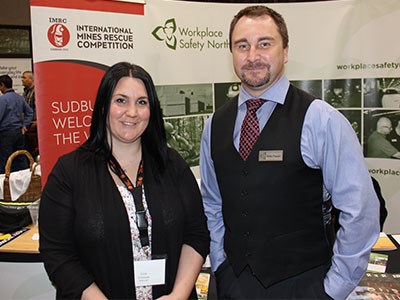It’s rare that being the tamest conference in town is considered a sign of success.
But for the 2016 Mining Health and Safety Conference, it was exactly what they wanted.
“Taming high-risk hazards” was the theme of Workplace Safety North’s (WSN) annual April conference in Sudbury. The theme was chosen as a response to findings in last year’s provincial mining health, safety and prevention review, which were less than favourable.
“We’re not seeing a downward trend in workplace injuries or fatalities,” said Mike Parent, the mining director at WSN. “The things that are causing critical injuries and fatalities are common hazards, nothing new.”
The review came up with 18 recommendations and clarified who was responsible for each.
“Everybody’s got a role, from a frontline worker to executive management, in taming high risk hazards,” said Parent. “It’s multiple failures that cause these issues.”
Various levels were represented by the 275 attendees and 31 trade booths at the three-day conference. At the event itself, WSN chose to focus on five major risks and ways to mitigate them: ground falling on people, interactions between people and equipment, improper water management, occupational disease (primarily respirable hazards), and fatigue.
In his role at WSN, Parent is working on two particular projects that aim to reduce risk and improve safety in the short and long term, and close the gaps between different levels in the industry.
For the short term, WSN will be offering risk assessment workshops with MIRARCO, the Sudbury mining innovation hub. The workshops will run in Timmins May 10 and 11, and in Sudbury May 17 and 18.
They hope the workshops will improve risk assessment and tame hazards, and deal with the immediate concerns voiced by the review and industry - but WSN is far from near sighted.
“Right now, if there’s a rash of injuries and fatalities everyone's on the reactive, but you need to take a step back and ID red flags before something happens,” said Cindy Schiewek, WSN’s culture, learning development and audit specialist.
For the long term, they’ve developed a Climate Assessment and Audit Tool (CAAT )that works as an Internal Responsibility System (IRS). The ministry describes an IRS as “a system where everyone has direct responsibility for health and safety as an essential part of his or her job.”
“The IRS is a really fuzzy concept that people don’t want to define, but what this review did was give us an opportunity not to define it, but to put context in it,” Schiewek.
She said an IRS system brings together the systems and culture in a workplace to determine where risk lies, and how to address it. It involves things like perception surveys of all corporate levels to gauge how consistent things like communication, leadership and safety culture really are.
Bryan Wilson has been piloting the CAAT as general manager for North American Palladium’s Lac des Iles Mine.
“Everybody has a little bit of an idea of where they think the culture of their organization is, but nothing's been available as a tool to measure both culture and systems,” said Wilson. “This CAAT audit tool has given us the ability to get the heartbeat of where we are as an organization.”
Wilson said that not all of the data collected by the tool is good news, but that it’s important for exposing areas that need to be worked on.
“It’s just one of the tools that we want to give back to the industry so they can accurately truly check their state,” said Schiewek. “The whole idea behind the CAAT is status quo is not acceptable right now and we need to take a step back and look at things.”




